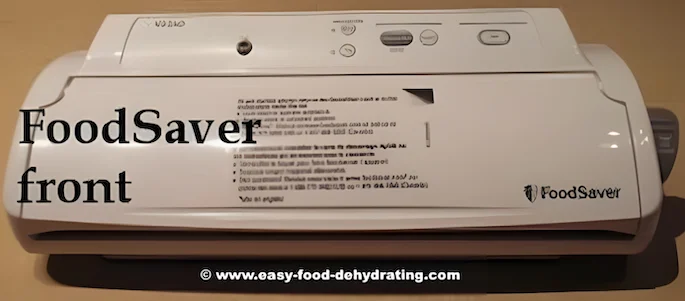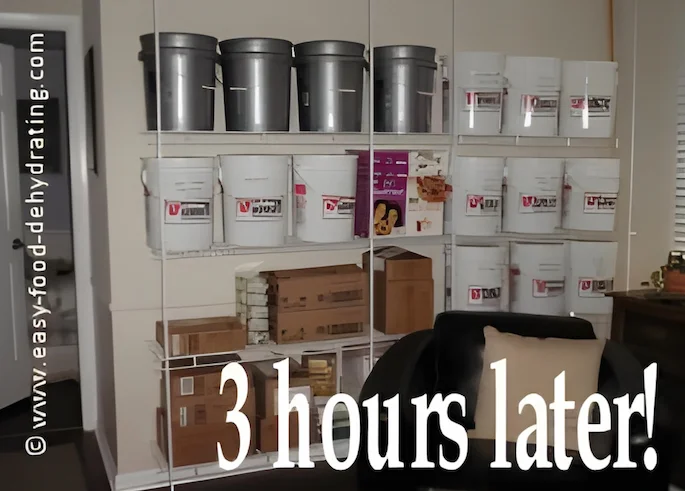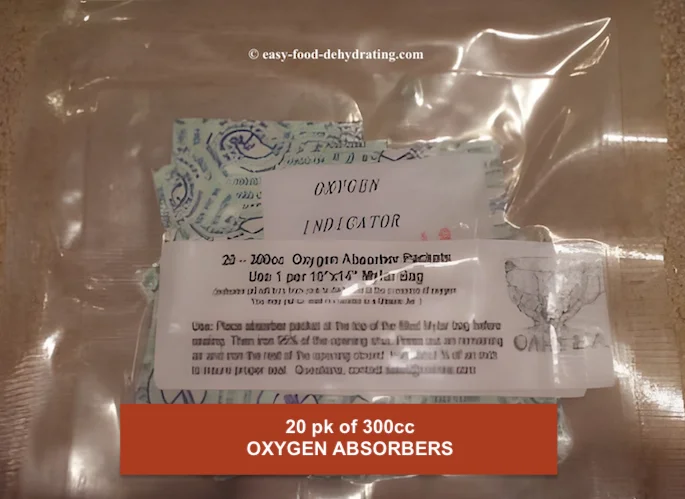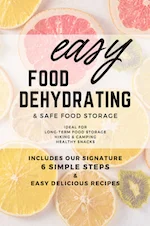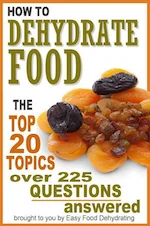- Home
- How to Store Dehydrated Food Safey for Long Term Storage
How to Store Dehydrated Food
For Long-Term Storage

Susan Gast | Author and blogger at Bored Boomers, Beesville Books, A New Sober You and Easy Food Dehydrating
It's time to learn how to store dehydrated food properly. Whether for short-term use, or long-term... it's important to pay attention to how you handle it before packing it away.
Before we get going: Shown above is my FoodSaver brand V2240 food vacuum-sealer I use. It's an oldie, but goody. It's over ten years old! Getting the right equipment pays dividends. Read more about food vacuum sealers here.
Believe it or not, I didn't know that text you see on the lid "peels" off - ha! It's just a sticker for reference. It only took me ten years to figure that out... better late than never.
Vacuum sealing dehydrated food pays off, but first - here are a few FAQs...
Frequently Asked Questions:
How to store dehydrated food?
How to store dehydrated food?
The page you're on right now gives you an overview of what you need to know in order to store food safely.
Click any of the links in this area for full deets.
Storing dehydrated food in Mylar bags?
Storing dehydrated food in Mylar bags?
Storing food in Mylar bags is addressed further down this page.
Vacuum sealed dehydrated food shelf life?
Vacuum sealed dehydrated food shelf life?
The question of how long does vacuum sealed food last is a valid question and it depends on the type of foods dried. Foods with a naturally lower moisture content will last longer than food with a naturally higher moisture content (think oranges vs cabbage).
Here's a quick comparison of the shelf life of vacuum sealed dehydrated food:
Naturally dry foods:
- Shelf life: Up to 25 years! Due to their low moisture content (5-10%), naturally dry foods like nuts, seeds, and grains have the longest shelf life when dehydrated and vacuum sealed.
- Examples: Rice, beans, lentils, oats, quinoa, almonds, walnuts, sunflower seeds.
More moist foods:
- Shelf life: 1-12 months, depending on moisture content. Foods with higher moisture content (10-20%) like fruits and vegetables have a shorter shelf life after dehydration, even when vacuum sealed correctly.
- Examples: Fruits (strawberries, bananas, apples), vegetables (peas, carrots, tomatoes), meat jerky.
Key factors affecting shelf life:
- Initial moisture content: The drier the food, the longer it will last.
- Oxygen exposure: Vacuum sealing removes oxygen, which helps prevent oxidation (browning) and spoilage.
- Storage temperature: Cooler temperatures (below 60°F) slow down spoilage.
- Light exposure: Light degrades nutrients and accelerates spoilage.
Throughout Easy Food Dehydrating you'll notice I mention "keeping the three enemies" at bay: Light, Air, and Moisture.
How long does dehydrated food last in Mylar bags?
How long does dehydrated food last in Mylar bags?
Great question, and that totally depends on how well you dehydrated your food and vacuum-sealed it. Did you add an oxygen absorber in the vacuum sealer bag before drawing out the air? If you did all that properly, then the answer is a year or longer.
It also depends on
how dry the food was before dehydrating. Meaning? If you vacuum-sealed
salt or sugar, it's "pretty dry" to begin with.
On the other hand, more-moist foods like tomatoes, or celery for instance, would depend on how much moisture remained when you vacuum-sealed them. That's why I like to condition fruits and veggies before they are vacuum-sealed. Don't forget to add the oxygen absorber into the bag (or Mason jar) before vacuum-sealing!
How to Store Dehydrated Food: Get the Gloves On!
Wear Latex Gloves so that you don't transfer germs from your hands to the food. (There are latex-free gloves available if you're allergic to latex).
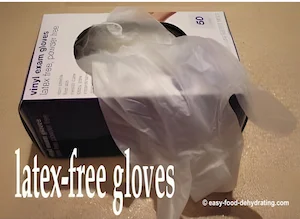
I use my latex gloves more than once; I wash my hands while wearing them in the kitchen sink, and dry them off on a clean towel.
I then drape them over my dish draining rack—so the latex gloves are ready for another use.
When the dehydrating is done and after a day of conditioning - or overnight - it's time to vacuum seal our fruits, vegetables, and meats! Now we're ready to store our dehydrated food!
Latex Gloves at Amazon
ComfitWear Latex Gloves 100-pk
- The Latex Pro-Tection Glove™
- 100 Disposable Gloves Powder-Free
- Food Safety and Compliance, Powder-Free
- 100 Disposable Exam Gloves
As an Amazon Associate, I earn commission from qualifying purchases. The price you pay does not increase. Read disclosure here.
How to Store Dehydrated Food for the Long-Term:
Save Money By Vacuum-Sealing Food—Use Oxygen Absorbers!
It's important when food vacuum-sealing your dried fruit and vegetables that you have an 'oxygen absorber' tucked inside your food vacuum-sealer bag or jar.
The little oxygen absorber packs absorb oxygen and are readily available in different sizes, such as the smallest at 50cc, then 100cc, 300cc, and up to a whopping 2000cc.
Read more about the reason for different-sized oxygen packs here as it depends upon what size container your dehydrated foods will finally be stored in.
Oxygen Absorbers at Amazon
NOTE:
50cc are perfect for small jars and containers. Ideal for keeping spices and smaller dried foods fresh.
100cc are great for quart-sized jars and vacuum-sealer bags. The most versatile size for everyday use.
- PackFreshUSA Oxygen Absorbers
- 200-Pack
- Food-Grade, Non-Toxic
- Oxy-Sorb Oxygen Absorbers
- 100-Pack
- Long-Term Food Storage Freshness Protection
- Oxy-Sorb Oxygen Absorbers
- Bags of 20 (60 Count total)
- Super Effective for Dried Goods
- Oxy-Sorb Oxygen Absorbers
- Pack of 10
- I use these for airtight bins and buckets
As an Amazon Associate, I earn commission from qualifying purchases. The price you pay does not increase. Read disclosure here.
How to Store Dehydrated Food in Mylar Bags
After vacuum-sealing individual packages, do this:
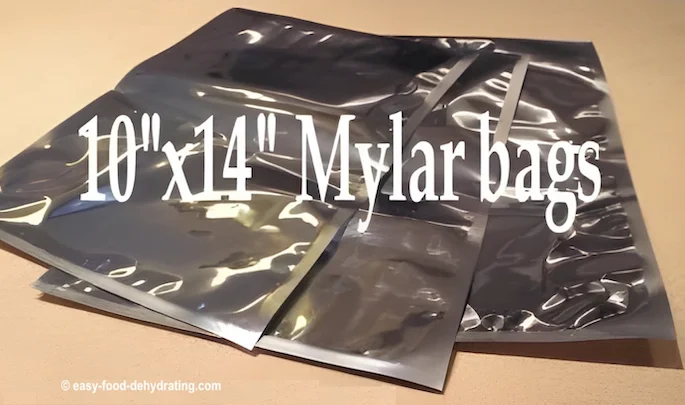
After vacuum-sealing dehydrated fruits and vegetables in the food vacuum sealer bags. it's time to store them in Mylar bags as an additional layer of protection.
NOTE: We do not vacuum the air from the Mylar bags, we simply seal the Mylar bag. It's only necessary to remove the air from the vacuum-sealed bags of food.
There are ready-made food vacuum sealer bags— and there are food vacuum sealer rolls readily available to make the perfect-length bag... here's a bit of info regarding the rolls below:
My Newest Discovery for Food Vacuum Sealer ROLLS:
Here's where to get this great deal on Amazon:
Wevac Vacuum Sealer Rolls
Wevac Vacuum Sealer Rolls - make your own size bag using these 8" x 50' and 11" x 50' roll 2-pack for Food Saver, Seal a Meal, or Weston. Commercial Grade, BPA Free, Heavy Duty,
Great for food vacuum storage, meal prep or sous vide applications!
This two-pack purchase is a "no-brainer." Watch the video to see why!
As an Amazon Associate, I earn commission from qualifying purchases. The price you pay does not increase. Read disclosure here.
But Back to Mylar Bags at Amazon
Dry-Packs 1-Gallon ShieldPro Mylar Bags
- 10" x 14" Dry-Packs ShieldPro Mylar Bags
- Includes 60x 300cc Oxygen Absorbers (in packs of 20)
- 10" x 14" Genuine Mylar Bags for Long-Term Food Storage
- Pack of 50
- No oxygen absorbers included
* As an Amazon Associate, I earn from qualifying purchases.
The price you pay does not increase.
Use Mason Jars for Daily/Weekly Usage
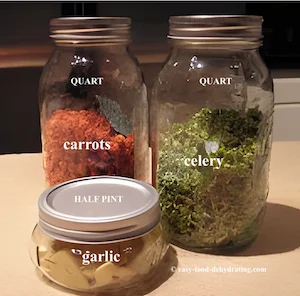
When storing dehydrated fruit and vegetables for daily or weekly use, try using different-sized airtight Mason jars that sit nicely on your upper kitchen cabinet shelves.
Remember to add an oxygen absorber into each jar, then screw the lid on. Read about how and why to use different-sized oxygen absorbers here.
Below the Amazon Mason jar links is a great tip on how to prevent punctured bags.
Read on to find out!
Amazon has Really Great Prices on Mason Jars
Mason Jars Regular Mouth Quart Jars
- Ball brand regular mouth Glass Mason Jars. Quart size (32oz)
- Package of 12
Mason Jars Wide Mouth Pint Jars
- Ball brand wide mouth Glass Mason Jars. Pint size (16oz)
- Package of 12
Mason Jars Wide Mouth Half Pint Jars
- Ball brand wide mouth Glass Mason Jars. Half-Pint (8oz)
- Package of 12
As an Amazon Associate, I earn commission from qualifying purchases. The price you pay does not increase. Read disclosure here.
Mylar Bags, Bins, and Buckets
Safely Store Dehydrated Food in Spare Closets or the Garage!
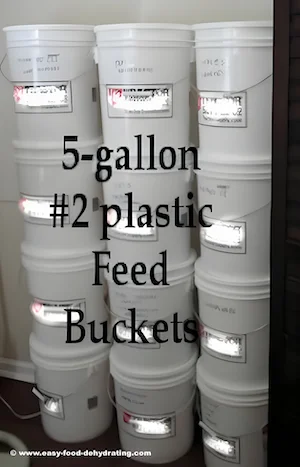
This is the tip I referred to earlier, about lessening the possibility of punctured bags:
I choose to wrap up my vacuum-packed packages with cheap plastic wrap. This keeps the sharp edges from puncturing the other packets—and then I put them into my Mylar bags.
Mylar bags are made from a polyester film and are very shiny in appearance; they are very tough and tear-resistant and are ideal for long-term food packaging.
They provide an extra layer of protection to our individual food packets.
And for final storage in a garage, for instance, put the Mylar bags in plastic-lidded bins or feed buckets with lids. Doing this makes it easy to move, is water-proof, bug-proof, and air-tight!
If you're wondering if there are special instructions for ORGANIC foods, check out my post: Best Organic Dried Foods Long-Term Storage Family Guide.
Here Are ALL the Storing Food Links
In Case You Missed One!
Here Are ALL the Storing Food Links
In Case You Missed One!
Our Great Wall of... Dehydrated Food and Canned Goods!
This is how you create space for your dehydrated food where there previously was none! Click here to see the end result of our 8' span of shelving shown in the photo.
Don't forget to check out my optional way of protecting dehydrated food vacuum-sealed packages by reading the Plastic Wrap Guide.
Now you know how to store dehydrated food, and pretty much all the items mentioned are for sale at the biggest website store in the world: Amazon.com — (so no worries there!)
For those of you who have written in asking about storing dry goods, read this page for how to store flour, salt, and sugar.
Thanks for stopping by how to store dehydrated food. Now you know what things you need to get - along with a dehydrator! Read more about dehydrators here.
Don't forget to grab your free Six Simple Steps eBook! It’s packed with tips for dehydrating everything from fruits and veggies to dog treats. Get it here.
Before You Go...
If you like the content, please give me some love by clicking on the 🩷 in the lower right hand corner (on just about all my pages). This signals to me that you find it enjoyable and useful. Thank you so much!
